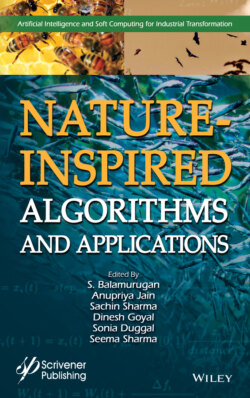Читать книгу Nature-Inspired Algorithms and Applications - Группа авторов - Страница 23
1.5.1.4 Familiar NIC Algorithms 1.5.1.4.1 Boids
ОглавлениеBoids is a one kind of artificial life simulation introduced by Craig Reynolds. The goal of the simulation is to repeat the behavior of group of species especially birds. Rather than controlling the associations of a whole rush, notwithstanding, the boids simulation just indicates the conduct of every individual feathered creature. With just a couple of basic principles, the program figures out how to produce an outcome that is intricate and reasonable enough to be utilized as a structure for computer designs applications, for example, computer created social liveliness in movie films.
The name “boid” relates to an abbreviated adaptation of “bird-oid object”, which is known as object like creation of birds. By chance, “boid” is likewise a New York Metropolitan lingo articulation for “feathered creature like bird”. In place of with most artificial life simulations, boids is a case of new behavior, that is, the difficulty of Boids emerges from the collaboration of individual specialists which is referred as boids, right now to a lot of straightforward standards. The standards applied in the most straightforward Boids world are as per the separation which is known as direct crowding of local group of local birds; next is alignment which is referred as direct for regular caption of group of local birds; and at last, cohesion which is referred as direct movement of regular location of group of local birds.
Most complicated principles can be included, for example, obstruction shirking, and objective chasing. The development of Boids can be portrayed as either disordered as parting gatherings and wild conduct or methodical. Surprising practices, for example, parting runs and rejoining in the wake of keeping away from deterrents, can be viewed as evolving. The boids structure is frequently utilized in computer designs, giving practical looking demonstrations of groups of feathered creatures and different animals, for example, schools of fish or crowds of creatures.
Another model simulation of group of birds have been developed by Frank Heppner and Ulf Grenander in 1990. The model has three main rules, namely, homing, velocity regulation, and interaction, in which homing is referred as every individual of the group try to be constant in a specific area; velocity regulation is referred as every individual of group tries to make a movement of fly within a definite predefined speed of flight; and interaction is referred to group of birds, where, when they are near to others, they will try to make a movement and, with large distance to others, they will not get impact, else will try to make a movement nearest to each other.
One of the essential highlights of this model (as opposed to Reynolds model) is the consideration of arbitrary unsettling influences. It simulates the unsettling influences with a Poisson stochastic procedure; anyway, one of the shortcomings of this model is that it would not yield satisfiable outcomes without these aggravations. The boid is the demonstration of birds in Reynolds flocking simulation model. Each boid item ought to in any event have the accompanying credits to define the state it is in. Their location is referred as coordinates of the recent location of boid, course is referred as recent course of the boid, and velocity is referred as rate as the boid is migrating.
The course and speed could obviously be spoken to by an equal speed vector. In any case, frequently more credits are expected to make the reproduction all the more persuading. Setting an upper boundary for how quick the boids can move and turn is a typical improvement. Raynolds unique usage essentially characterized the neighbors as the boids inside a specific sweep. Another conceivable meaning of the area is to let each boid take a gander at the N nearest boids. This postulation endeavors to contrast the two definitions with discover qualities and shortcomings in the two definitions and find under what conditions either is unrivaled.
Right now, the rule for the algorithm is that boid has a part around it crossing 300°, fixated on the boid that is ongoing. Some other boids are, right now, considered “neighbors” or (to utilize Reynolds’ term) “flockmates”.
1 Each boid ought to modify it, making a beeline to stay away from impacts and keep up an agreeable separation of one boid-span with its neighbors. This is the “Division” part of the calculation. The one boid-radius might be avoided; however, it ought to resemble an elastic band, adjusting back properly.
2 Each boid ought to furthermore modify it, making a beeline to be nearer to the normal heading of the different boids in its neighborhood, as long as it does not meddle with the main standard. This is the “arrangement” part of the calculation.
3 Each boid should turn itself toward the normal situation of its group of birds, as long as this does not cause crash or essentially meddle with the subsequent principle.
